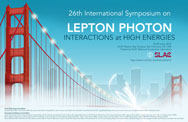Welcome to DU!
The truly grassroots left-of-center political community where regular people, not algorithms, drive the discussions and set the standards.
Join the community:
Create a free account
Support DU (and get rid of ads!):
Become a Star Member
Latest Breaking News
General Discussion
The DU Lounge
All Forums
Issue Forums
Culture Forums
Alliance Forums
Region Forums
Support Forums
Help & Search
Science
Related: About this forumWhat do you get if you cross a cloud chamber with a violin?
Music. Of course.
From Scientific American: Cosmic Rays Make Beautiful Music in Kirke’s “Cloud Chamber”:
Not everyone appreciates the beauty of a simple cloud chamber, but Alexis Kirke is a fellow aficionado. He’s the composer in residence at the Plymouth Marine Institute in England, a research fellow at Plymouth University, and holds PhDs in both the arts and technology. So it’s not surprising that much of his multimedia work (across multiple platforms) has a scientific bent — including “Cloud Chamber,” a duet for violin and “live” subatomic particles. Yeah, you read that right: subatomic particles. The performance requires not just a human violinist, but a working cloud chamber with a camera mounted over it. The camera records the tracks left by cosmic rays and converts them into synthesized music.
<snip>
The cloud chamber was invented by Scottish physicist Charles Thomas Rees Wilson in 1895 at Cambridge University’s famed Cavendish Laboratory. Wilson was interested in the weather and wanted a means of reproducing the condensation of clouds in the laboratory. This happens as the result of a sudden expansion of the volume of some closed vessel filled with air saturated with water vapor. Said expansion causes a drop in temperature, and makes the air supersaturated, resulting in condensation. And he brought the tools of physics available at that time to bear on the challenge. He focused on how ions serve as nuclei for water droplets, and even began photographing the formation of those droplets.
By 1910, Wilson had figured out he could use his cloud chamber device to detect charged particles, since they would leave a trail of ions — and water droplets — as they passed through the gas in the chamber. He took the very first photographs of the tracks left by alpha and beta rays.
<snip>
The cloud chamber was invented by Scottish physicist Charles Thomas Rees Wilson in 1895 at Cambridge University’s famed Cavendish Laboratory. Wilson was interested in the weather and wanted a means of reproducing the condensation of clouds in the laboratory. This happens as the result of a sudden expansion of the volume of some closed vessel filled with air saturated with water vapor. Said expansion causes a drop in temperature, and makes the air supersaturated, resulting in condensation. And he brought the tools of physics available at that time to bear on the challenge. He focused on how ions serve as nuclei for water droplets, and even began photographing the formation of those droplets.
By 1910, Wilson had figured out he could use his cloud chamber device to detect charged particles, since they would leave a trail of ions — and water droplets — as they passed through the gas in the chamber. He took the very first photographs of the tracks left by alpha and beta rays.

Tracks from Wilson's original cloud chamber. The radioactive particle tracks
are seen by the white cloud streaks.
Source: CERN Courier. http://outreach.phas.ubc.ca/phys420/p420_97/chris/p4.htm
For “Cloud Chamber” performances, Kirke uses a cloud chamber containing radium 225. Two of his colleagues, Anna Troisi and Antonino Chiaramonte, worked with center head Eduardo Miranda to device a visual-recognition-to-sound interface that they dubbed the Cloud Catcher, capable of functioning in real time. Per Wired:
“In the duet, a camera above a cloud chamber follows the particle tracks and converts them into synthesized music, which accompanies the violin…. An amplified version of the violin part was also sent to an electromagnetic field system positioned near the particles. Thus [the violinist's] playing creates a variable force field in the chamber, influencing the way the particles behave. This ensures that the duet between radioactive particles and violinist is as dynamic as possible.”
This may be as close to the "music of the microcosmos" as you can get. Schoenberg never sounded so good. All you quarks out there, listen up. down, charmed, strange, truth and beauty.
Performed at the 2013 Lepton Photon Conference, hosted by SLAC National Accelerator Laboratory, June 24, 2013 - June 29, 2013

InfoView thread info, including edit history
TrashPut this thread in your Trash Can (My DU » Trash Can)
BookmarkAdd this thread to your Bookmarks (My DU » Bookmarks)
0 replies, 1234 views
ShareGet links to this post and/or share on social media
AlertAlert this post for a rule violation
PowersThere are no powers you can use on this post
EditCannot edit other people's posts
ReplyReply to this post
EditCannot edit other people's posts
Rec (3)
ReplyReply to this post